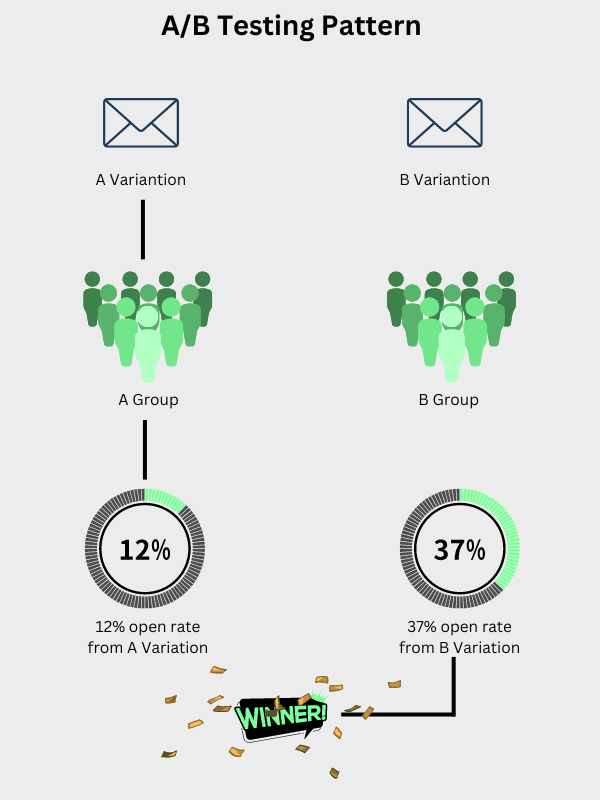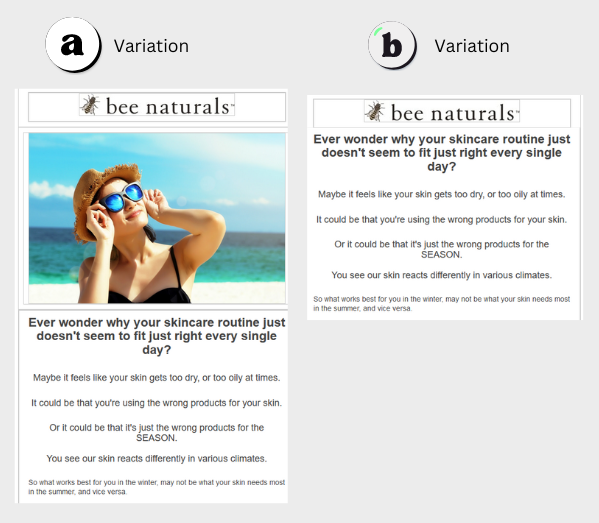Introduction:
Email marketing remains one of the most effective tools for businesses to engage with their audience, nurture leads, and drive conversions. However, with the increasing competition for attention in crowded inboxes, it has become crucial for marketers to continually refine their email strategies. Enter A/B testing—a powerful technique that enables marketers to make data-driven decisions and optimize their email campaigns for maximum impact. In this blog, we’ll explore the concept of A/B testing in email marketing, its benefits, and provide examples of how it can be leveraged to drive better results.
Understanding A/B Testing and Its Significance:
What is A/B Testing? A/B testing, also known as split testing, involves creating two or more variations (A and B) of a marketing element, such as an email subject line, content, design, or call-to-action (CTA). These variations are then randomly distributed to a subset of the target audience, and their performance is measured against predefined goals and metrics.
REMEMBER : A/B test only ONE variable at a time for better analysis of your testing.

The Benefits of A/B Testing in Email Marketing:
→Data-driven Decision Making: A/B testing allows marketers to gather concrete data and insights about their target audience’s preferences, enabling them to make informed decisions based on real-world results.
→Improved Engagement and Conversions: By identifying the elements that resonate most with subscribers, A/B testing helps optimize email campaigns for higher open rates, click-through rates (CTR), conversions, and ultimately, revenue.
→Cost-effective Experimentation: A/B testing provides a cost-effective way to test different email variations before rolling out the most effective version to the entire subscriber base.
→Continuous Optimization: A/B testing is an ongoing process that enables marketers to continually refine their email marketing strategies, adapt to changing audience preferences, and stay ahead of the competition.
A/B Test the following variables:
1] Subject Line Testing: Subject lines play a crucial role in email open rates. Marketers can A/B test different subject line variations to determine the most compelling option. For example, testing a straightforward subject line against a more creative or personalized one can provide insights into what resonates best with the audience.
2] Call-to-Action Testing: The placement, color, wording, and design of a call-to-action (CTA) button can significantly impact click-through rates. A/B testing can help determine the most effective CTA by comparing different variations. For instance, you can A/B test CTA with text “Buy Now” “Shop Now,” “Get Started,” “Download Now,” or “Learn More” button can reveal which call-to-action drives higher conversions.
3] Pre-Header text: A/B testing the pre-header text is another valuable variable to consider in email marketing. The pre-header text is the brief snippet of text that appears immediately after the subject line in an email client’s preview pane or mobile notification.
When testing the pre-header text, you can experiment with different approaches to make it more compelling and enticing for recipients to open the email. Here are some ideas to explore:
-
Copy from the first line of the email: Hello there, welcome to aliXemail! You’re joining thousands of people who learn basic to advance level email marketing from us…
-
Short summary: Welcome to Marketing Chamber! I’m excited to show you can be successful in email marketing.
-
Call to action: Here are 101 ways you can start automating your work.
Click here to learn more about pre-header and subject line.
4] Content Testing: Testing different content formats, such as short vs. long-form emails, or visual vs. text-heavy emails, can provide insights into subscribers’ preferences. Marketers can experiment with various content elements, such as images, videos, testimonials, or product descriptions, to identify the most engaging format.
5] Design and Layout Testing: The design and layout of an email can greatly influence user experience and engagement. A/B testing different design elements, such as color schemes, font styles, header images, or the number of columns, can help identify the most visually appealing and user-friendly layout.
6] From Name / Sender Name: Test different sender names to see if using a specific individual’s name, company name, or a combination of both affects open rates and engagement.
Example: You can test short vs long name [ Bighat vs Bighat store USA ] OR store name vs person from store [ Bighat store Vs Ali from Bighat store ]
7] Personalization: Explore the effectiveness of personalization techniques, such as using the recipient’s name, location, or previous purchase history. Test personalized vs. non-personalized emails to determine if customization improves engagement.
8] Timing and Frequency: Test different send times and frequencies to find the optimal schedule for your audience. Evaluate the impact of sending emails on different days of the week or at specific times during the day.
Best Practices for Effective A/B Testing:
- Define Clear Objectives: Clearly outline the goals and metrics you want to measure before conducting an A/B test. Whether it’s increasing open rates, click-through rates, or conversions, having well-defined objectives will ensure focused and meaningful testing.
- Test One Element at a Time: To accurately measure the impact of a specific change, isolate and test only one element at a time. Testing multiple changes simultaneously can lead to confounding results
Hope you loved our blog ‘A/B Testing Secrets for Effective Email Marketing’ : )
PS: Also A/B test different variables in different flows like abandon site flow, browse abandon flow, abandon cart flow, expected next order flow, abandon checkout flow, thank you flow, cross-sell/up-sell flow, birthday flow and more.
”Wanna take your E-commerce business to next level with proven email marketing strategies? You’re just ONE step away. DM ‘Klaviyo consultation’ at info@alixemail.com”
Don’t forget to subscribe our YouTube channel [ Marketing Chamber ] for klaviyo tutorials. For Urdu/Hindi klaviyo tutorials click here. For English klaviyo tutorials click here.
FAQs:
1] What is A/B testing?
A/B testing, also known as split testing, is a method used to compare two or more variations of a marketing element to determine which one performs better in achieving a specific goal or metric.
2] Why is A/B testing important?
A/B testing allows marketers to make data-driven decisions by gathering insights about their target audience’s preferences. It helps optimize marketing campaigns, improve engagement and conversions, and maximize the effectiveness of marketing efforts.
3] What can I A/B test in email marketing?
In email marketing, you can A/B test various elements such as subject lines, email content, call-to-action buttons, sender names, personalization, design and layout, pre-header text, and timing/frequency.
4] How do I conduct an A/B test?
To conduct an A/B test, you create two or more variations of an element you want to test. Randomly divide your audience into different groups and expose each group to a different variation. Measure and compare the performance of each variation based on specific metrics, such as open rates, click-through rates, or conversions.
5] What metrics should I measure during an A/B test?
The metrics you measure depend on your specific goals. Common metrics to track in A/B testing include open rates, click-through rates, conversion rates, revenue generated, bounce rates, and unsubscribe rates.
6] How many variations should I test at once?
To ensure accurate results, it is recommended to test only one variable at a time. Testing multiple variations simultaneously can make it challenging to determine the exact impact of each change on the outcome.
7] What statistical significance should I aim for in A/B testing?
It is generally recommended to aim for a statistical significance level of at least 95%. This ensures a high confidence level that the observed differences in performance between variations are not due to chance.
8] How often should I conduct A/B tests?
A/B testing should be an ongoing process. Regularly conduct tests to continuously refine and optimize your marketing strategies. As audience preferences and market dynamics change, A/B testing allows you to adapt and stay ahead of the competition.








